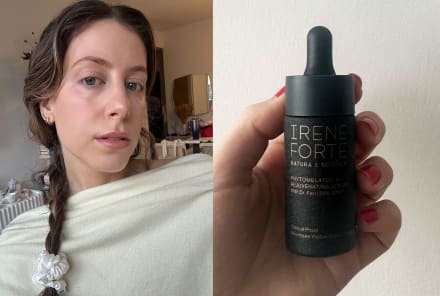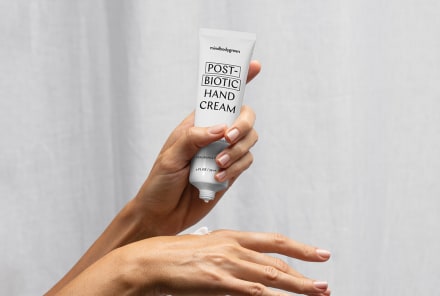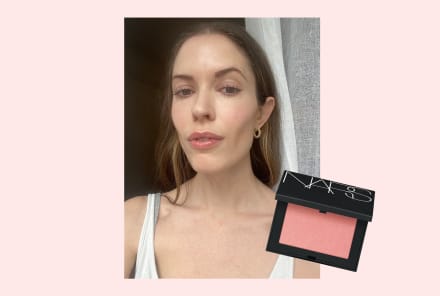Advertisement
How To Get Rid Of Peeling Skin: 9 Easy Tips, Backed By Experts

Itchy, peeling skin—need I say more? While specific causes can vary (sunburns, dryness, a budding relationship with retinol), shedding skin is no fun; oftentimes, your skin can also feel tight, sensitive, and raw.
And if your skin is flaking at the moment, you may be wondering how to get it back to smooth and supple, stat. Ahead, experts weigh in on how to get rid of peeling skin.
Why does skin peel?
Skin peeling refers to when the outer layer of the skin (your epidermis) sheds, which can happen for a host of reasons: sun damage, over-exfoliation, or just dryness overall.
In each case, the protective barrier of the skin is disrupted, which can lead to inflammation, cracks, and irritation—and sometimes, when those skin cells are so damaged that they die, that's when they tend to slough off in flakes.
What to do about it.
If you've scrolled this far, chances are you have some peeling skin on your hands (or face, or arms, or chest, or...). Here's what you can do to get rid of those flakes:
Have patience.
Full disclosure: There's nothing you can do to "heal" or revive peeling skin. "Once the skin is burned, there is not much you can do to prevent it from peeling off; the cells are damaged, so it is safer for them to come off anyway," Morgan Rabach, M.D., a board-certified dermatologist and co-founder of LM Medical in NYC, told us about peeling sunburns.
That said, the best thing to do is wait for the skin to heal on its own. You can soothe the area with certain moisturizers to ward off inflammation and pain (which we explain further below), but in terms of getting rid of the flakes themselves—well, that just takes time.
Keep out of the sun.
On that note, make sure to keep your peeling skin away from the sun's rays. Your skin barrier is literally made to protect you from UV rays and environmental irritants, so when it's stripped and weakened (à la sunburn or over-exfoliation), your raw, exposed skin may need some extra help in that department.
"Exposing fresh skin that hasn't fully formed a protective barrier can cause discoloration," celebrity esthetician and dermatological nurse Natalie Aguilar previously told mbg. So you'll want to shield the vulnerable skin from the sun—and make sure to diligently slather on sunscreen.
Focus on moisture.
On the flip side, when your skin barrier is weakened, the best thing you can do is replenish it with supportive ingredients—think ceramides, hyaluronic acid, colloidal oat, oat oil, shea butter, and aloe (the original sunburn soother). Better yet, apply these hydrators on damp skin, like post-shower or face wash, so they can lock in that precious water.
"One should really keep skin care simple and baby the skin back to a healthy start. After all, baby skin is forming underneath," says Aguilar. And baby skin loves moisture.
Use gentle, fragrance-free products.
The underneath layers of your skin (which becomes exposed when your top layer peels) are super sensitive, so you might want to stick to a sensitive skin care routine—even if you don't usually identify with the skin type.
"Use bland emollients and moisturizers without fragrances or other additives," says board-certified dermatologist Michele Farber, M.D., of Schweiger Dermatology Group in NYC, and stick to gentle, nonstripping cleansers—like milk or cream washes. "[They] are gentle, don't burn, and won't strip skin of its natural moisture," Aguilar notes. Here, find our best soaps and face washes for sensitive skin.
Do not exfoliate.
Once your skin starts to peel off in flakes, you might naturally want to reach for the exfoliants. Best to scrub the dead, damaged skin off, no?
Actually, exfoliating the vulnerable skin (be it with a chemical or physical product) can only lead to more irritation As Farber warns, exfoliating peeling skin can even delay the healing process, as you're applying more trauma to the area. "Definitely avoid this," she told us.
Take cooler showers.
It's likely burned into your brain by now: Hot water can strip the natural oils and lipids from your skin, which can further compromise your already weakened skin barrier. Plus, cooler water can help soothe any inflammation—that's why experts recommend cold compresses for sunburns.
Pat your skin dry.
This tip works in two ways: First, you don't want to rub and tug at your peeling skin, lest you rip off the delicate patches before they're ready. But towels also act as a sneaky physical exfoliant—even the softest terry cloth can scrape at the skin if you swipe with too much pressure. And, remember, exfoliating your sensitive skin right now is a major no.
We always recommend patting the skin dry, but it's especially important to keep in mind while your skin is healing. Blot your skin post-wash, and perhaps leave it damp before slathering on a moisturizer or cream. You can also consider upgrading to a muslin cloth, which is multilayered, finely woven, and extremely soft on the skin.
Don't peel!
"Pulling or picking at flakes that aren't ready to come off can leave vulnerable skin raw and prone to scarring and pigmentation," says Aguilar. So do try to refrain from peeling the dead skin off yourself—moisturize and protect the skin barrier, and those flakes will naturally fall off when they're ready.
Rabach seconds the warning: "It's best to let the dead skin peel itself off naturally without pulling it, as you can tear further into the skin," she says.
See a derm.
If you're in severe pain or discomfort (say, you have incessant itching, bleeding, or even pustules), you might need a more targeted treatment. As always, consult a dermatologist if you have any lingering concerns about those flakes.
The takeaway.
Ultimately, the best thing you can do for peeling skin is to let it be—with time, the flakes will slough off all on their own. In the meantime, it's important to make sure you're not halting the process with any harsh ingredients or finicky fingers.
Watch Next
Enjoy some of our favorite clips from classes
Enjoy some of our favorite clips from classes
What Is Meditation?
Mindfulness/Spirituality | Light Watkins
Box Breathing
Mindfulness/Spirituality | Gwen Dittmar
What Breathwork Can Address
Mindfulness/Spirituality | Gwen Dittmar
The 8 Limbs of Yoga - What is Asana?
Yoga | Caley Alyssa
Two Standing Postures to Open Up Tight Hips
Yoga | Caley Alyssa
How Plants Can Optimize Athletic Performance
Nutrition | Rich Roll
What to Eat Before a Workout
Nutrition | Rich Roll
How Ayurveda Helps Us Navigate Modern Life
Nutrition | Sahara Rose
Messages About Love & Relationships
Love & Relationships | Esther Perel
Love Languages
Love & Relationships | Esther Perel
-v1646695196476.jpg?1148x800)

















